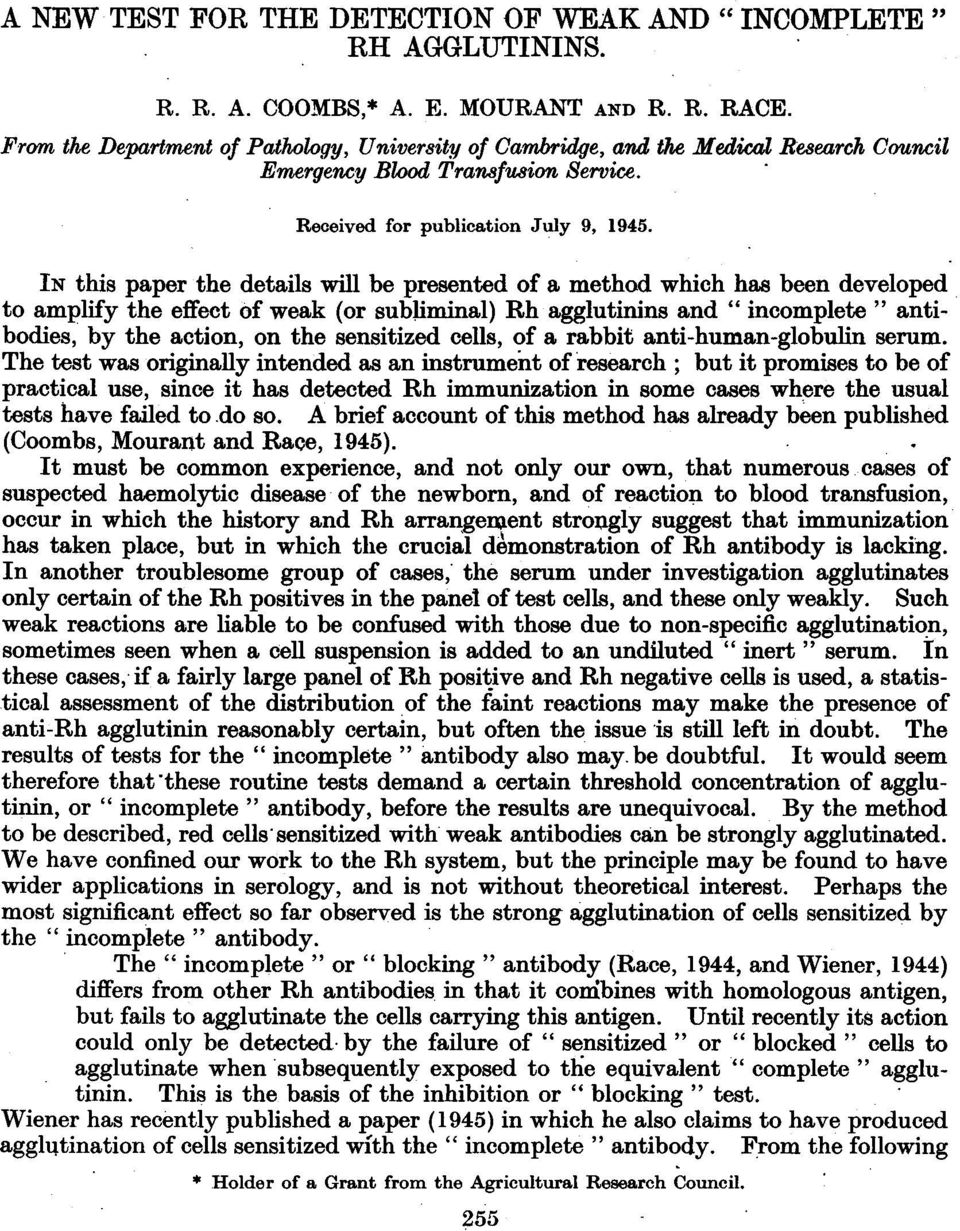
Reputation Activity
-
 Arno got a reaction from Yanxia in PCH - CrossmatchIf a transfusion is required and urgent (severe symptomatic anemia), a X-match in IAT at 37°C may be tested. You do not necessarily need P-negative blood (very scarce) unless severe transfusion refractory anemia which would support the need of P negative units. For transfusion, patient should be placed in a warm environment and ensuring that the transfused blood is (pre)warm as well.
Arno got a reaction from Yanxia in PCH - CrossmatchIf a transfusion is required and urgent (severe symptomatic anemia), a X-match in IAT at 37°C may be tested. You do not necessarily need P-negative blood (very scarce) unless severe transfusion refractory anemia which would support the need of P negative units. For transfusion, patient should be placed in a warm environment and ensuring that the transfused blood is (pre)warm as well.
Hereunder are some references:
Clinical and epidemiological features of paroxysmal cold hemoglobinuria: a systematic review - PMC
Autoimmune Hemolytic Anemia and Red Blood Cell Autoantibodies | Archives of Pathology & Laboratory Medicine
-
 Arno got a reaction from Malcolm Needs in PCH - CrossmatchIf a transfusion is required and urgent (severe symptomatic anemia), a X-match in IAT at 37°C may be tested. You do not necessarily need P-negative blood (very scarce) unless severe transfusion refractory anemia which would support the need of P negative units. For transfusion, patient should be placed in a warm environment and ensuring that the transfused blood is (pre)warm as well.
Arno got a reaction from Malcolm Needs in PCH - CrossmatchIf a transfusion is required and urgent (severe symptomatic anemia), a X-match in IAT at 37°C may be tested. You do not necessarily need P-negative blood (very scarce) unless severe transfusion refractory anemia which would support the need of P negative units. For transfusion, patient should be placed in a warm environment and ensuring that the transfused blood is (pre)warm as well.
Hereunder are some references:
Clinical and epidemiological features of paroxysmal cold hemoglobinuria: a systematic review - PMC
Autoimmune Hemolytic Anemia and Red Blood Cell Autoantibodies | Archives of Pathology & Laboratory Medicine
-
 Arno reacted to Malcolm Needs in PCH - CrossmatchIf it was that urgent a case, I can't see what else you can do, because thawing a pp unit that may not be necessary would be a terrible waste.
Arno reacted to Malcolm Needs in PCH - CrossmatchIf it was that urgent a case, I can't see what else you can do, because thawing a pp unit that may not be necessary would be a terrible waste.
-
 Arno reacted to Malcolm Needs in Plasma transfusionsAGREED - and killing the patient in some circumstances!!!!!!!!!!!!!!!!!!
Arno reacted to Malcolm Needs in Plasma transfusionsAGREED - and killing the patient in some circumstances!!!!!!!!!!!!!!!!!!
-
 Arno reacted to Neil Blumberg in Plasma transfusionsAlso, were any of the transfused units antigen positive? This is the quickest way to get a negative indirect antiglobulin test ;).
Arno reacted to Neil Blumberg in Plasma transfusionsAlso, were any of the transfused units antigen positive? This is the quickest way to get a negative indirect antiglobulin test ;).
-
 Arno reacted to Malcolm Needs in Plasma transfusionsI agree Darin, it is almost certainly a dilutional effect, BUT, it could also be the effect of a soluble antigen (obviously not within the Duffy Blood Group System). If the antibody had a specificity within, for example, the Lewis Blood Group System, or the Chido/Rodgers Blood Group System, the antigen in the plasma could well adsorb out the circulating antibody. That having been said, this explanation is FAR less likely than your suggestion of the dilutional effect.
Arno reacted to Malcolm Needs in Plasma transfusionsI agree Darin, it is almost certainly a dilutional effect, BUT, it could also be the effect of a soluble antigen (obviously not within the Duffy Blood Group System). If the antibody had a specificity within, for example, the Lewis Blood Group System, or the Chido/Rodgers Blood Group System, the antigen in the plasma could well adsorb out the circulating antibody. That having been said, this explanation is FAR less likely than your suggestion of the dilutional effect.
-
 Arno got a reaction from Yanxia in Maternal alloantibody, not detected in baby - how long for antigen negative unitsFor acquired maternal IgG antibodies (which may also be transferred postnatally through breast milk), assessing the antibody specificity (AbS) in the newborn, as previously mentioned, appears to be a reasonable approach. In addition, the Direct Antiglobulin Test (DAT) remains key, and performing an elution is important (even if the DAT result is negative). In your case, the negative DAT suggests that either the anti-N antibody did not cross the placenta, possibly due to being a naturally occurring IgM, and/or the baby is N-negative.
Arno got a reaction from Yanxia in Maternal alloantibody, not detected in baby - how long for antigen negative unitsFor acquired maternal IgG antibodies (which may also be transferred postnatally through breast milk), assessing the antibody specificity (AbS) in the newborn, as previously mentioned, appears to be a reasonable approach. In addition, the Direct Antiglobulin Test (DAT) remains key, and performing an elution is important (even if the DAT result is negative). In your case, the negative DAT suggests that either the anti-N antibody did not cross the placenta, possibly due to being a naturally occurring IgM, and/or the baby is N-negative.
-
 Arno got a reaction from Malcolm Needs in Maternal alloantibody, not detected in baby - how long for antigen negative unitsFor acquired maternal IgG antibodies (which may also be transferred postnatally through breast milk), assessing the antibody specificity (AbS) in the newborn, as previously mentioned, appears to be a reasonable approach. In addition, the Direct Antiglobulin Test (DAT) remains key, and performing an elution is important (even if the DAT result is negative). In your case, the negative DAT suggests that either the anti-N antibody did not cross the placenta, possibly due to being a naturally occurring IgM, and/or the baby is N-negative.
Arno got a reaction from Malcolm Needs in Maternal alloantibody, not detected in baby - how long for antigen negative unitsFor acquired maternal IgG antibodies (which may also be transferred postnatally through breast milk), assessing the antibody specificity (AbS) in the newborn, as previously mentioned, appears to be a reasonable approach. In addition, the Direct Antiglobulin Test (DAT) remains key, and performing an elution is important (even if the DAT result is negative). In your case, the negative DAT suggests that either the anti-N antibody did not cross the placenta, possibly due to being a naturally occurring IgM, and/or the baby is N-negative.
-
 Arno reacted to Malcolm Needs in Source of advice on transfusing patients with mismatched stem cell/bone marrow transplants?Sorry Neil, but I have to point out that this is not completely accurate. Any red cell antigens that are adsorbed onto the red cell surface, rather than being an integral part of the red cell membrane remain the type of the patient, rather than the donor. This is true of the Lewis phenotype (for instance, if the recipient was Le[a+b-], and the donor was Le[a-b+], after the transplant, the red cells will group as Le[a+b-], and not as Le[a-b+]}. This is also true of antigens within the Chido/Rodgers Blood Group System, and certain others.
Arno reacted to Malcolm Needs in Source of advice on transfusing patients with mismatched stem cell/bone marrow transplants?Sorry Neil, but I have to point out that this is not completely accurate. Any red cell antigens that are adsorbed onto the red cell surface, rather than being an integral part of the red cell membrane remain the type of the patient, rather than the donor. This is true of the Lewis phenotype (for instance, if the recipient was Le[a+b-], and the donor was Le[a-b+], after the transplant, the red cells will group as Le[a+b-], and not as Le[a-b+]}. This is also true of antigens within the Chido/Rodgers Blood Group System, and certain others.
If the recipient is a Secretor, they will continue to secrete ABO substance of the original ABO type, which, of course, will also be adsorbed onto the red cell surface (as well as being in the plasma, leading to the phenomenon of "accommodation", and this is why most recipients stay with a reverse group of "AB" after an ABO mis-matched stem cell/bone marrow transplant.
SORRY TO BE A PEDANT, PARTICULARLY AS I AGREE WITH EVERYTHING ELSE YOU HAVE WRITTEN!
-
 Arno reacted to Neil Blumberg in Giving same group really that necessaryPerhaps this is one rare physician who actually reads the medical literature on the subject or has thought things through.
Arno reacted to Neil Blumberg in Giving same group really that necessaryPerhaps this is one rare physician who actually reads the medical literature on the subject or has thought things through.
The history of this is very simple. Based upon the experience of severe or fatal hemolytic transfusion reactions to whole blood, it was discovered that when a patient's ABO type was unknown, and urgent transfusion was life saving, group O was the least likely to result in disaster. When group O red cells became available during the middle of the last century, with modest amounts of plasma left, it was decided by the then experts that this could be used for non-urgent, routine transfusions of all patients. So-called universal donor O red cells. The problem, with the 100% accuracy of hindsight, was that we had no evidence this is was good, much less optimal practice. But it was convenient. It meant blood banks didn't have to stock all 8 Rh and ABO types, so it was good for us in the transfusion service. It wasn't good for patients.
Why is that? Well, there is residual incompatible plasma with anti-A and anti-B in all group O red cells that haven't been washed or thoroughly volume depleted. Well, you might ask, and all of us have assumed for decades, that a few dozen milliliters of incompatible plasma is not a big deal. The answer, now known to some extent, is that it is a big deal for some patients who are groups A, AB and probably B. This small residual plasma can on rare occasions cause severe hemolysis. It's 100% severe if it happens to you as a patient. This has been known for decades. What is new is the data that recipients of ABO mismatched red cells (Group O in general) have a higher rate of red cell alloimmunization to other red cell antigens, (Transfusion 2012 Mar;52(3):635-40. doi: 10.1111/j.1537-2995.2011.03329.x; 2025 Mar;65(3):588-603. doi: 10.1111/trf.18135. higher rates of febrile and allergic reactions, (Transfusion 2012 Mar;52(3):635-40.doi: 10.1111/j.1537-2995.2011.03329.x.) higher rates of HLA alloimmunization, and perhaps overall higher rates of mortality (Transfusion. 2016 Mar;56(3):550-7.doi: 10.1111/trf.13376).
So, if you are a recipient, you want ABO identical transfusions, or compatible red cells that have had all or almost all of the plasma removed, as by washing, for example.
-
 Arno reacted to John C. Staley in Giving same group really that necessaryThat was my 1st thought as well!
Arno reacted to John C. Staley in Giving same group really that necessaryThat was my 1st thought as well!
-
 Arno reacted to Malcolm Needs in Giving same group really that necessaryNeil Blumberg, I'll leave this one to you!
Arno reacted to Malcolm Needs in Giving same group really that necessaryNeil Blumberg, I'll leave this one to you!
-
 Arno got a reaction from Malcolm Needs in BloodBankTalk: Anti-Jr(a)I just answered this question.
Arno got a reaction from Malcolm Needs in BloodBankTalk: Anti-Jr(a)I just answered this question.
My Score PASS
-
 Arno reacted to Malcolm Needs in Managing cord blood orders in MeditechI wonder if your providers have ever thought of looking at their patients SYMPTOMS, rather than costing a fortune by using a tick box method for ordering tests?????
Arno reacted to Malcolm Needs in Managing cord blood orders in MeditechI wonder if your providers have ever thought of looking at their patients SYMPTOMS, rather than costing a fortune by using a tick box method for ordering tests?????
Of course, I fully realise that this is a suggestion that can only be put forward to your providers by your Pathologist, as doing so yourself would probably get you into deep trouble.
-
 Arno reacted to Malcolm Needs in Managing cord blood orders in MeditechDid you mean that AuntiS. I fully confess there were times when I did!!!!!!!!!!!!!!!!!!!!!!!!!!!
Arno reacted to Malcolm Needs in Managing cord blood orders in MeditechDid you mean that AuntiS. I fully confess there were times when I did!!!!!!!!!!!!!!!!!!!!!!!!!!!
-
 Agree that in “not recently transfused”patients, eluates are of no clinical use unless you like seeing panagglutinins.😜 Negative eluates occur in some drug dependent examples but the clinical information is paramount in such situations in any case.
Agree that in “not recently transfused”patients, eluates are of no clinical use unless you like seeing panagglutinins.😜 Negative eluates occur in some drug dependent examples but the clinical information is paramount in such situations in any case.
-
 Many, many years ago now, when I was working at the old Westminster Hospital in London as a quite junior member of the Blood Transfusion staff, I spent quite a few hours working on a sample from a patient with a positive DAT, trying to determine the specificity, in order to see whether the antibody was an allo- or an auto-antibody. This included the use of several very rare red cells that I had frozen down and also examining the eluate. After many happy hours, I had got precisely nowhere, and so sent a sample to my former colleges at the International Blood Group Reference Laboratory.
Many, many years ago now, when I was working at the old Westminster Hospital in London as a quite junior member of the Blood Transfusion staff, I spent quite a few hours working on a sample from a patient with a positive DAT, trying to determine the specificity, in order to see whether the antibody was an allo- or an auto-antibody. This included the use of several very rare red cells that I had frozen down and also examining the eluate. After many happy hours, I had got precisely nowhere, and so sent a sample to my former colleges at the International Blood Group Reference Laboratory.
I received a somewhat "spicy" report from my heroine Joyce Poole, who explained to me, in words of one syllable, that I had rather been wasting my time, rare cell collection and the laboratory's money as, in almost all cases, the specificity would be found to be an auto-anti-Rh17 or auto-anti-Rh18!!!!!
Since then, I have reverted to doing as little as possible on such samples and, when I retired 43 years later, and, as far as I know, none of the patients ever died as a result. There was a close one once, when I was working on a sample on a Saturday on-call in the Red Cell Reference Laboratory at NHSBT-Tooting Centre. I was working on a sample that was overtly a case of wAIHA. After several allo-adsorptions, I was finally able to provide "suitable blood". It was only at the last minute that the computers came back on after an unplanned downtime, and it appeared that the patient was known, from many years previously as having an allo-anti-Vel!!!!!!! As you can imagine, I did several more tests before I released the blood (on Pathologist's orders), as there was absolutely no evidence of an anti-Vel (auto- or allo-) in the present sample - but it did give me a bit of a turn!!!!!!!!!!!!
I would recommend a thorough reading of Petz LD, Garratty G. Immune Hemolytic Anemias. 2nd edition, 2004, Churchill-Livingstone. ISBN 978-0-443-08559-8.
Other than that and, possibly, looking at the patient's sample at a more molecular level (as noelrbrown suggests above), I really wouldn't do much else, except that I would put a little note with the blood to be transfused to remind the doctors and nurses on the ward to be vigilant with their patient observations.
ALL OF THE ABOVE HAVING BEEN SAID, I AM NOT, AND NEVER HAVE BEEN, MEDICALLY QUALIFIED!!!!!!
-
 Arno got a reaction from SbbPerson in New educational opportunity: an Update on Fetal and Neonatal Alloimmune Thrombocytopenia (FNAIT)Hello everyone,
Arno got a reaction from SbbPerson in New educational opportunity: an Update on Fetal and Neonatal Alloimmune Thrombocytopenia (FNAIT)Hello everyone,
Here is a new 100% educational opportunity (with PACE credits) for those who are interested in FNAIT. Here is the link to register Webinar | Bio-Rad
-
 Arno got a reaction from traci89 in New educational opportunity: an Update on Fetal and Neonatal Alloimmune Thrombocytopenia (FNAIT)Hello everyone,
Arno got a reaction from traci89 in New educational opportunity: an Update on Fetal and Neonatal Alloimmune Thrombocytopenia (FNAIT)Hello everyone,
Here is a new 100% educational opportunity (with PACE credits) for those who are interested in FNAIT. Here is the link to register Webinar | Bio-Rad
-
 Arno got a reaction from Malcolm Needs in New educational opportunity: an Update on Fetal and Neonatal Alloimmune Thrombocytopenia (FNAIT)Hello everyone,
Arno got a reaction from Malcolm Needs in New educational opportunity: an Update on Fetal and Neonatal Alloimmune Thrombocytopenia (FNAIT)Hello everyone,
Here is a new 100% educational opportunity (with PACE credits) for those who are interested in FNAIT. Here is the link to register Webinar | Bio-Rad
-
 Arno got a reaction from SbbPerson in Drug Induced Immune Hemolytic Anemia (DIIHA) vs warm/cold Auto Immune Hemolytic Anemia (AIHA)I thought for the first time I would share one of the educational webinars we have been producing with the ISBT because it is a fascinating topic addressed by a great lecturer (Sue Johnson).
Arno got a reaction from SbbPerson in Drug Induced Immune Hemolytic Anemia (DIIHA) vs warm/cold Auto Immune Hemolytic Anemia (AIHA)I thought for the first time I would share one of the educational webinars we have been producing with the ISBT because it is a fascinating topic addressed by a great lecturer (Sue Johnson).
So do miss out on the opportunity to watch the recording of this ISBT educational webinar Could it be drugs? How to differentiate AIHA from DIIHA Start zoom webinar | The International Society of Blood Transfusion (ISBT)
-
 Arno reacted to Ensis01 in Ficin vs PapainMy understanding was availability and cost. Probably due to FDA and European drug administrations having very different opinions (that list is long).
Arno reacted to Ensis01 in Ficin vs PapainMy understanding was availability and cost. Probably due to FDA and European drug administrations having very different opinions (that list is long).
-
 Arno reacted to Neil Blumberg in Blood used organ donation servicesThe standards probably don't apply to post-mortem transfusions. I cannot imagine why an organ harvest surgery would require transfusion at all, but I'm not a surgeon. I've had requests to transfuse platelets and plasma to organ donor patients, which we've uniformly denied. I'd need some explanation of why transfusion, which is pro-inflammatory, immunomodulatory and pro-thrombotic, would benefit the potential organ recipient. There is so much misinformation, partially promulgated by the transfusion medicine community, of the "benefits" of transfusion, that it is sometimes difficult to explain to clinicians why transfusion is a bad idea in many situations.
Arno reacted to Neil Blumberg in Blood used organ donation servicesThe standards probably don't apply to post-mortem transfusions. I cannot imagine why an organ harvest surgery would require transfusion at all, but I'm not a surgeon. I've had requests to transfuse platelets and plasma to organ donor patients, which we've uniformly denied. I'd need some explanation of why transfusion, which is pro-inflammatory, immunomodulatory and pro-thrombotic, would benefit the potential organ recipient. There is so much misinformation, partially promulgated by the transfusion medicine community, of the "benefits" of transfusion, that it is sometimes difficult to explain to clinicians why transfusion is a bad idea in many situations.
-
 Arno got a reaction from Ally in Drug Induced Immune Hemolytic Anemia (DIIHA) vs warm/cold Auto Immune Hemolytic Anemia (AIHA)I thought for the first time I would share one of the educational webinars we have been producing with the ISBT because it is a fascinating topic addressed by a great lecturer (Sue Johnson).
Arno got a reaction from Ally in Drug Induced Immune Hemolytic Anemia (DIIHA) vs warm/cold Auto Immune Hemolytic Anemia (AIHA)I thought for the first time I would share one of the educational webinars we have been producing with the ISBT because it is a fascinating topic addressed by a great lecturer (Sue Johnson).
So do miss out on the opportunity to watch the recording of this ISBT educational webinar Could it be drugs? How to differentiate AIHA from DIIHA Start zoom webinar | The International Society of Blood Transfusion (ISBT)
-
 Arno got a reaction from Malcolm Needs in Drug Induced Immune Hemolytic Anemia (DIIHA) vs warm/cold Auto Immune Hemolytic Anemia (AIHA)I thought for the first time I would share one of the educational webinars we have been producing with the ISBT because it is a fascinating topic addressed by a great lecturer (Sue Johnson).
Arno got a reaction from Malcolm Needs in Drug Induced Immune Hemolytic Anemia (DIIHA) vs warm/cold Auto Immune Hemolytic Anemia (AIHA)I thought for the first time I would share one of the educational webinars we have been producing with the ISBT because it is a fascinating topic addressed by a great lecturer (Sue Johnson).
So do miss out on the opportunity to watch the recording of this ISBT educational webinar Could it be drugs? How to differentiate AIHA from DIIHA Start zoom webinar | The International Society of Blood Transfusion (ISBT)



